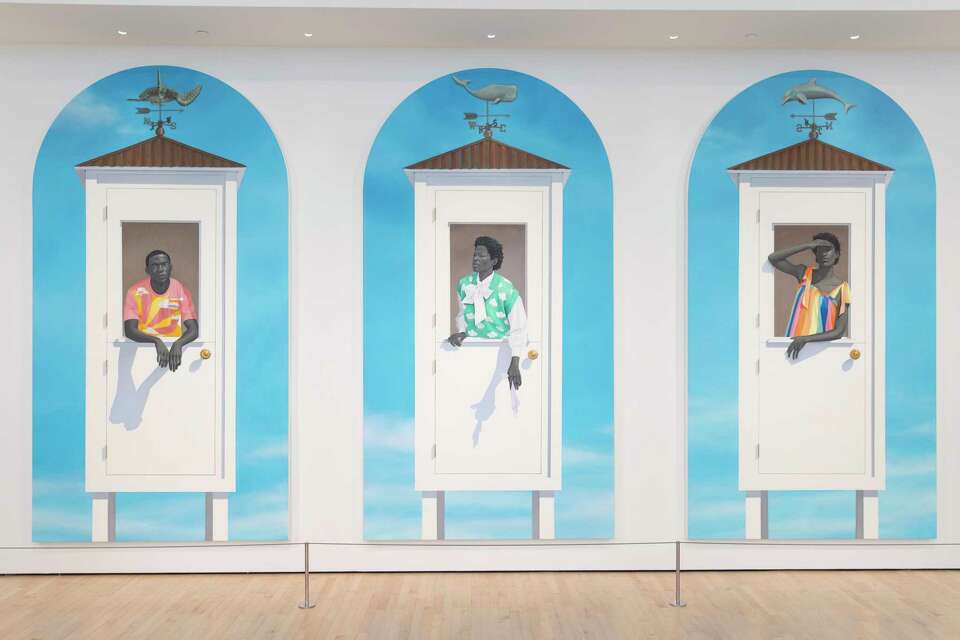
When one first enters the Amy Sherald: American Sublime exhibition in the San Francisco Museum of Modern Art, they are instantly greeted by grey faces. Each of Sherald’s stylistic choices hold meaning: bright colors, flat backgrounds, playfully patterned clothes and grey skin, as if the race of the subjects has been removed from the portraits themselves. After surveying the entirety of the exhibit, another stylistic choice emerges: All of Sherald’s subjects are Black.
This focus on Black portraiture began when Sherald noticed the sheer lack of representation, especially in more elegant spaces like fine art, pop culture and other forms of media, in comparison to the violence the Black community is so often stereotyped to be surrounded by. Her aim is to depict Black people in everyday life, where the Black community has been so often omitted from.
“[Sherald] didn’t see herself reflected in portraits that were showing American history, and so she seems to be working to rewrite that narrative,” said museum-goer Alisha. “Seeing how she’s placing people in these very normal American situations, and drawing on these iconic American figures like cowboys and beauty queens, that’s really, really poignant.”
The title of the exhibit, “Sublime,” refers to something of excellence and grandeur. By portraying American history whilst using Black subjects to convey a feeling of awe, Sherald relays a clear theme; there is beauty in America, and so much of that beauty comes from Black involvement. Sherald’s focus on Black portraiture in American spaces or themes isn’t to attack history as we know it — it’s to celebrate the past through inclusion of Black figures.
“[Sherald is] trying to deracialize, and so sublime seems like a good word to help people get in that mindset,” said museum-goer Randi Wexler. “She paints for everybody. That’s her desire; to show Black Americans as just like the rest of us.”
Sherald also focuses on re-entering Black representation into American history. At the beginning of the exhibit hangs “What’s precious inside of him does not care to be known by the mind in ways that diminish its presence (All American).” The portrait depicts a man in stereotypically “American” clothes: a cowboy hat, a collared shirt patterned like the American flag, blue jeans and a large buckle with a horse. Sherald’s works often feature symbolic names drawn from poems or literary works. The words “All American” at the end of the title, as well as the outfit, imply that this piece is about having an identity that is often called into question because it is not deemed “authentic”.
“[Sherald is] really working to minimize race as the focus, and so you see all these really beautiful, vibrant colors and details that you hone in on where you’re really not thinking about race,” Alisha said. “It’s people, it’s humanity … I hope everybody can see some aspect that they can relate to in the world.”
Further into the exhibit, one sees another example of this reintegration of Black figures into our past. “For love, and for country” instantly captures one’s attention with the sheer size of the painting. It stands at a whopping 123 1/4 x 93 1/8 inches, taking up the entirety of a wall. Its power as headliner of the exhibit is clear.
In the painting, Sherald reimagines the famous photo of a soldier kissing a nurse on V-Day, the end of World War II, replacing the subjects with two Black sailors embracing one another in a loving kiss. With her subject focused style, Sherald forces the viewer to acknowledge the censored African-American and LGBTQ+ contributions in the war effort. The two sailors also wear more modernized forms of a “classic” sailor outfit, which possibly alludes to how the change in times and norms gives way to a wider coverage of who exactly makes up our nation.
“[Sherald] addresses [race, gender and sexuality] in a very interesting way,” said museum-goer Isabelle. “There was one painting of this man, and … the title was, ‘Guide me no more’. It was a man dressed in Western colonial clothing with a boat. [There’s] significance [with] slaves being brought on a ship and then being represented in that way … As much as we like to think that race is talked about, it’s really not.”
Sherald’s paintings comment on the present as well, seen in her full-body portrait of Breonna Taylor. Sherald dedicated extreme care into ensuring that she had encapsulated Taylor’s personality by frequently speaking with Taylor’s mother. Taylor stands, with her hand on her hip and a strong, slightly playful expression on her face. She wears a long, flowy blue dress that Sherald had commissioned from a Black female designer after hearing of Taylor’s interest in fashion. While her jewelry is minimal, Sherald made sure to include an engagement ring on her finger, as a symbol of the love Taylor shared with her partner, Kenneth Walker, and what could have been had the past played out in a better way.
Through the painting of Breonna Taylor, one is able to see just how much love Sherald puts into her works. Each piece has a message to be shared, which is carried both through the painting itself, and the highly symbolic titles. All in all, the Amy Sherald: American Sublime exhibit was a beautiful one. Every single piece carried a story with it, and it was fascinating to see the character of each subject drawn out through clothing and subtle expressions. Sherald’s opinions and sentiments are infused into each piece as well, which makes for a fascinating experience as one tries to understand the meaning behind the pieces. I can say, with a resounding “yes,” that this exhibit was worth seeing.




